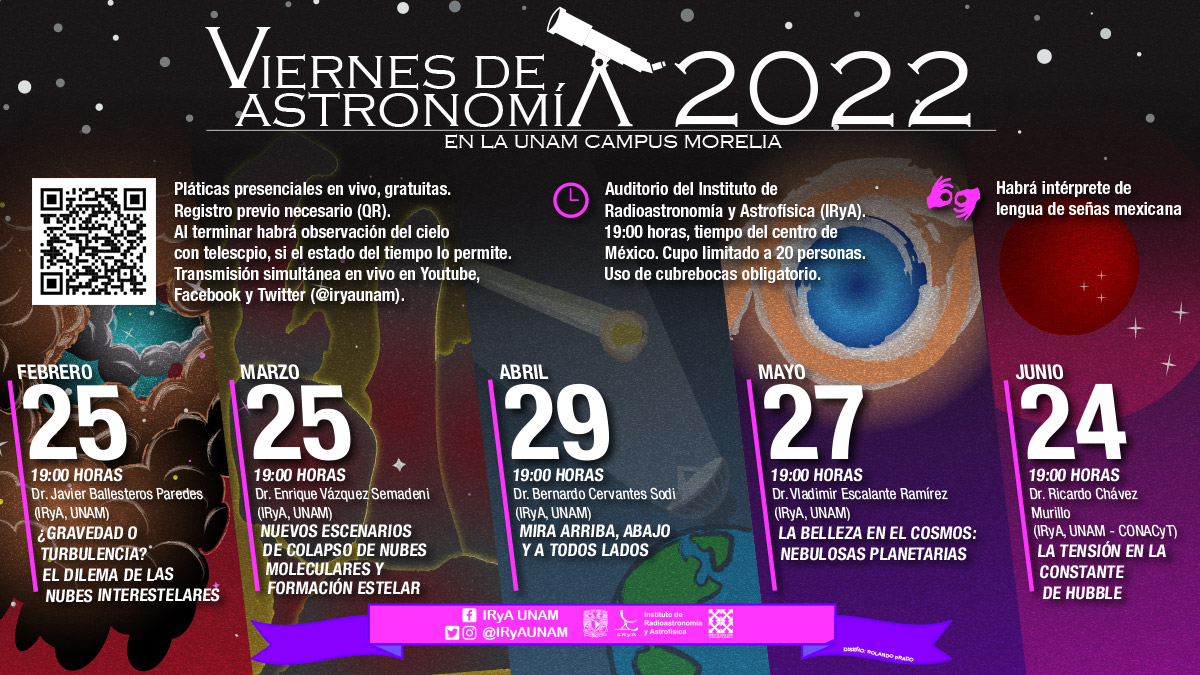The Instituto de Radioastronomía y Astrofísica (IRyA), or Institute for Radioastronomy and Astrophysics, at UNAM Campus Morelia, invites people to attend its public talks cycle Viernes de Astronomía, or Astronomy Fridays. In this cycle, IRyA’s researchers will share talks in Spanish directed to the general public about diverse astronomy topics.
In this first semester of 2022, five of IRyA’s astronomers will talk about several topics regarding their own research, and also general astronomy topics, including the possibility of a collision of an object with Earth, new ideas about star formation, the beauty of planetary nebulae, and the tension arising from the study of the universe as a whole.
The five talks this semester will take place in a hybrid format, i.e., both in-person and online via social media, the last Friday of each month from February to June, at 7 pm (central Mexico time). To attend in person to IRyA’s auditorium, an online registration per person is required before each talk. The link to register is shared at the end of this text.
Talks will be simultaneously broadcast through IRyA’s Facebook , Youtube and Twitter profiles, as well as the Facebook profile of the Michoacan’s Astronomical Society (SAMAC), IRyA’s partners in this talk cycle.
At the end of each talk, if the weather allows it, people at the in-person event will be able to observe astronomical objects through our telescopes, thanks to the collaboration of IRyA’s graduate students and SAMAC’s members. Also, all talks will include a Mexican Sign Language interpreter.
To start the cycle, Dr. Javier Ballesteros Paredes will share the talk “¿Gravedad o turbulencia? El dilema de las nubes interestelares”, this Friday, 25 of February at 7 pm (central Mexico time). In this talk, he will share the story about how stars are born from molecular clouds, and wether turbulence or gravity dominate their formation process, according to recent research results.
Dr. Ballesteros is an expert in molecular clouds and turbulence in the interstellar medium. From March to June, chronologically: Dr. Enrique Vázquez Semadeni, an expert in gravitational collapse and star formation; Dr. Bernardo Cervantes Sodi, who will discuss the collision probability of an object with Earth, in a talk inspired by the recent film “Don’t look up”; Dr. Vladimir Escalante Ramírez, who will talk about the impressive beauty of planetary nebulae; and Dr. Ricardo Chávez Murillo, an expert in studying the universe as a whole, who will share about the recent tension in the Hubble parameter, which measures the rate of expansion of the universe.
To attend the talks in person at IRyA UNAM’s auditorium, please register here:
https://www.irya.unam.mx/web/es/divulgacion/convocatorias-divulgacion
One registry per person, before each talk.
IRyA UNAM social media (in Spanish)
To watch the talks in the Viernes de Astronomía cycle and more about our outreach and public engagement activities, follow us in social media:
Facebook: www.facebook.com/iryaunam
Youtube: www.youtube.com/iryaunam
Twitter: www.twitter.com/iryaunam
Instagram: www.instagram.com/iryaunam
About IRyA, UNAM
The Instituto de Radioastronomía y Astrofísica (IRyA), or Institute for Radioastronomy and Astrophysics is an academic unit at UNAM, Campus Morelia, Mexico. We perform high-level and high-impact research in the areas of interstellar medium, star formation, evolved stars, high energy astrophysics, Galactic dynamics and structure, extragalactic astronomy and cosmology. We contribute to the education of high-level human resources through a postgraduate program, and we have close contact with society through diverse outreach programs.
If you are interested in our Institute, visit the English version of our webpage, www.irya.unam.mx/web/en
Media contact:
Dr. René A. Ortega Minakata
Outreach and Science Communication
IRyA UNAM Campus Morelia
Text: IRyA UNAM





